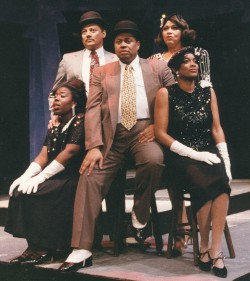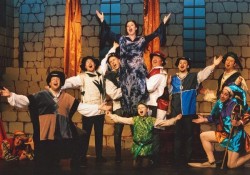The Peoria Players legacy hearkens back to the vaudeville era, when jazz was king and the cinema was a kind of magic. Nearly a century later, the little theatre that could is a deeply-rooted fixture in the local arts.
The audience waits in the shadows… a hush falls over them as the lights dim. Spotlights flood the stage, and the theater dissolves into an imaginary world, at least for the evening. The trance won’t break until the house lights rise once more, and the audience shuffles back into the foreign light of reality, carrying images of the show’s most vivid scenes with them.
The stage can be a rare refuge from the buzz of the modern world. It houses one of humanity’s oldest art forms, but more importantly, it brings people together to witness the age-old magic of live performance. And for nearly a century, the Peoria Players Theatre has infused that dramatic element into the Peoria-area community.
Peoria Players puts on about half a dozen shows each year, ranging from the traditional classics to those fresh off Broadway. One of the oldest community theatres in the country, it hasn’t missed a season since the first performance of Oliphant Down’s The Maker of Dreams in 1919.
And not only do its productions appeal to a wide range of people, says longtime business administrator Nicki Haschke, they can involve anyone who’s interested in participating. Many theatergoers claim they are just as good—or better—than the same show performed in Chicago or on Broadway.
Jenny Parkhurst, marketing director at Corn Stock Theatre, has participated in many Peoria Players productions over the years. She cites community involvement as the cornerstone of its endurance. “We have such a rich history, and the Peoria community is so supportive of the arts,” she says. “It makes people want to dig roots in this town and stay.”
Birth of the Little Theatre
Characterized by a relatively small size and a localized base of talent, community theatres started to become popular in the United States after the turn of the 20th century. American poet and playwright Percy MacKaye called it the “civic theatre”—a way for everyone to participate in the theatre at their leisure. Some of the earliest community theatre groups in the nation were formed here in Illinois and Wisconsin.
Peoria’s own community theatre has survived everything the 20th century tossed its way, from wars to economic disasters. Bob Brandes, who started out as an actor and stage helper at Peoria Players in 1954, has lived through some of these trying times. When the idea was born in 1919, he says, community theatres were still few and far between.
 The theatre got its start, Brandes says, when a prominent local citizen—the author, educator and entertainer, William Hawley Smith—gathered some friends together one summer evening to discuss the need for a “little theatre,” the name commonly used for “community theatre” at the time. That night, the Peoria Players Theatre was born.
The theatre got its start, Brandes says, when a prominent local citizen—the author, educator and entertainer, William Hawley Smith—gathered some friends together one summer evening to discuss the need for a “little theatre,” the name commonly used for “community theatre” at the time. That night, the Peoria Players Theatre was born.
Without a permanent home, the theatre’s first shows were performed in the upstairs auditorium at the Peoria Women’s Club on Fayette Street in downtown Peoria. They opened on October 6, 1919, with The Maker of Dreams. “From that night on,” claims Brandes, “they never had a dark season in the history of Peoria Players.”
When the bustle and shine of the Roaring Twenties gave way to the sobering age of the Great Depression, the theatre trudged on, albeit more slowly. World War II delivered another blow, costing the theatre some of its local talent, as the men were off fighting. “They had a hard time getting male leads, and they didn’t know what they were going to do,” explains Brandes. “Somebody came up with the idea of getting seniors in high school interested. They put mustaches and suits on them, and that’s what they did for leading men.”
When the war was over, the Players’ season doubled from three shows to six, which remains the case today. At the time, however, all six shows were plays, as the first musical was not introduced until 1958. It was Moss Hart’s Lady in the Dark, and it was well received by the community. “We got our feet wet with that one,” recalls Brandes, who helped out backstage on the production. “We got a lot of encouragement, and we went on to do two musicals every season.”
Today, the theatre shows about four musicals each year. Last season closed with Chicago, in another performance comparable to the Broadway production, according to Brandes. “There’s an enormous amount of talent in this area—we should be very proud of that.”
Having left the Peoria Women’s Club in 1933, the theatre moved into a former firehouse on Jackson Street, where it remained until the construction of I-74 caused it to relocate once more. On the Saturday after Thanksgiving in 1957, The Teahouse of the August Moon opened at its new location in Lakeview Park, where the Peoria Players have called home ever since.
Showtime!
No performance could be possible without a full team working behind the scenes. Each production is led by a group that includes a director, choreographer, music director, costumer and production secretary, as well as a slew of volunteers for props, lights and sound. But first, the season has to be mapped out.
Each year, after receiving submissions for both shows and directors, the board of directors finalizes the season’s lineup. The decision involves a delicate balance, says Haschke, as the actors, directors and other volunteers sometimes want to bring in new, unproven shows, while the better-known titles are typically the bigger ticket sellers. “We are a business,” she explains, “and at the end of the day, people won’t always come see a show that isn’t as well known.”
 A large musical requires about 20 to 25 volunteers—not including the cast, says Lisa Jeans, board president. “In addition to our patrons and the community, no nonprofit organization can be successful without volunteers,” she explains. “[They] are the backbone of our theater.” Many directors bring along a crew of people with whom they have worked with in the past, while Haschke keeps a file of other potential help. About a week before opening night, a flurry of additional hands are available to change sets and costumes, do hair and makeup, and organize props.
A large musical requires about 20 to 25 volunteers—not including the cast, says Lisa Jeans, board president. “In addition to our patrons and the community, no nonprofit organization can be successful without volunteers,” she explains. “[They] are the backbone of our theater.” Many directors bring along a crew of people with whom they have worked with in the past, while Haschke keeps a file of other potential help. About a week before opening night, a flurry of additional hands are available to change sets and costumes, do hair and makeup, and organize props.
A sense of continuity also helps to strengthen the theatre’s legacy, says Jeans, as long-time employees like Haschke and her mother, box office manager Sherry Haschke, have become the faces of the theatre. “The people who get involved with theatre become like family,” she explains. “It’s a really positive way to get involved in the community.”
More Than a Cast
Many community theatre participants get bitten by the “theatre bug,” Jeans says, staying involved for years after their first show. That’s in large part due to the kind of family that’s created by a production.
“I have been doing this for more than 30 years, so I feel like I was raised in the theatre community,” she says. “You get to be creative… [and] meet new friends, and we all get to do what we love to do.”
Parkhurst has been a part of the local theatre community since the late seventies, when she began acting at Peoria Players. It requires commitment and hard work, she says, but people return because they “love working with a team to create something.”
She even met her husband beneath the stage lights, as child actors in the Peoria Players production of Brigadoon in the winter of ‘77. The following spring, they were cast opposite one another as Tom Sawyer and Becky Thatcher in The Adventures of Tom Sawyer, and they’ve been together ever since. “There are a lot of good memories there for me,” she adds.
Erin Durbin has been involved with Peoria Players since 2002, having acted, directed and worked backstage. It’s the people, she explains, that are the highlight of any production—especially after spending months together in preparation. “A lot of times you’re doing shows with people you’ve done shows with before… It’s almost like being in school together.
“After the show is over, a couple months later you decide to do another show,” she continues. “When you walk in for the first night of rehearsals, you recognize a bunch of familiar faces.”
A Century Worth Celebrating
One hundred consecutive seasons is no small feat, particularly in light of the historic curveballs with which the theatre has coped over the years. It’s a cause for celebration, says Haschke, and plans are already in the works for the Peoria Players’ centennial anniversary in 2019.
But after the hundreds of shows performed on its stage, the focus remains on community, just as it did when the theatre was without a home, held together by the faith of its founders. “I have made a lot of good friends and met a lot of talented, interesting people over the years,” Haschke says. “The people have always been the best part of my job.” a&s
The Peoria Players 2012-2013 season opens on September 7th with a performance of 9 to 5: The Musical, directed by Nate Downs. For dates and additional details, call the box office at (309) 688-4473 or visit peoriaplayers.org.


